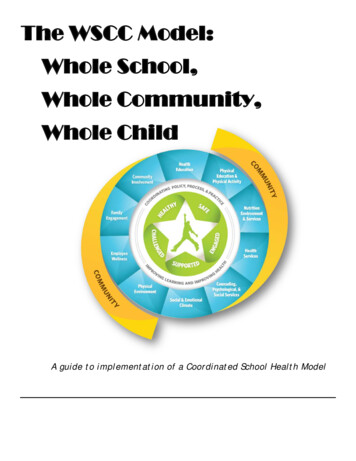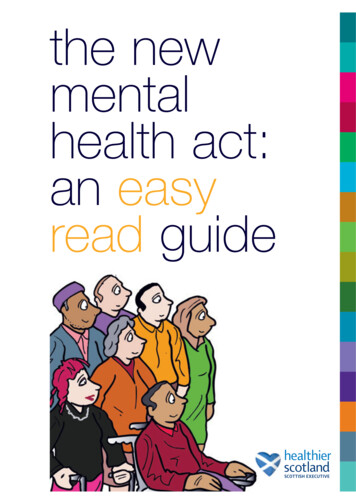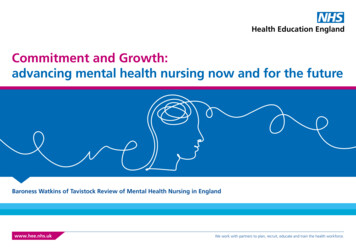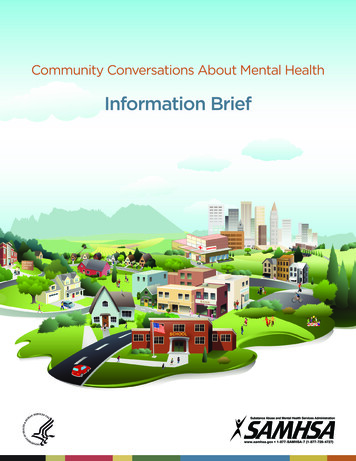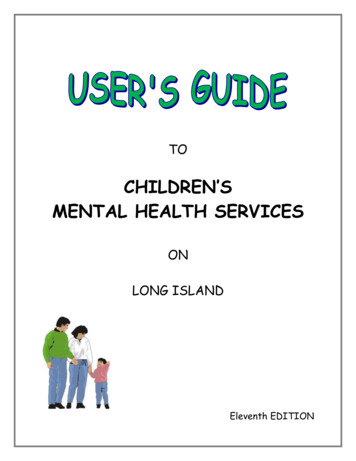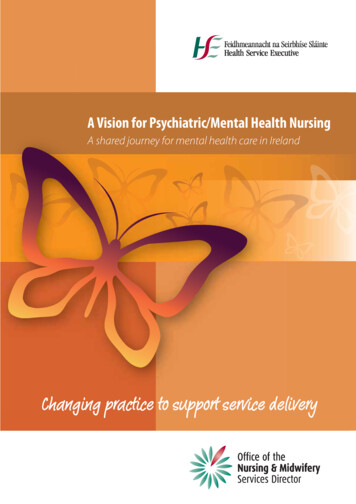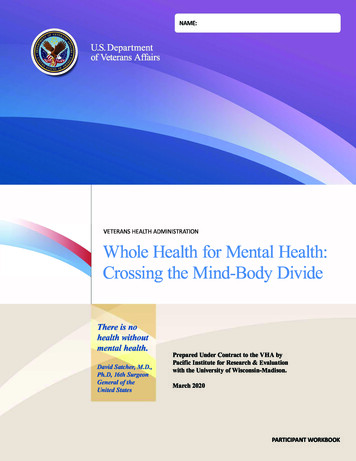
Transcription
NameVETERANS HEALTH ADMINISTRATIONWhole Health for Mental Health:Crossing the Mind-Body DivideThere is nohealth withoutmental health.David Satcher, M.D.,Ph.D, 16th SurgeonGeneral of theUnited StatesPrepared Under Contract to the VHA byPacific Institute for Research & Evaluationwith the University of Wisconsin-Madison.March2020PARTICIPANT WORKBOOK
Whole Health for Mental Health:Crossing the Mind-Body DivideAGENDADAY 1 MORNINGTimeTopic/Title7:30am – 8:00amRegistration8:00am – 8:30am1. Welcome and Course Overview Leadership Welcome Who’s in the Room? Introductions Course Materials Community Agreements8:30am – 9:30am2. Why Are We Here? Learning Objectives: What This Course is, What it is Not What is Whole Mental Health? Challenges The Scope of the Problem Points of Tension in Mental Health Care9:30am – 9:40amBreak9:40am – 10:55am3. Interconnections: Self-Care Molecular and Genetic Connections The Gut Connection Group Activity: Interconnections and Self-Care for MentalHealth Connecting Power of the Mind with the Other Areas ofSelf-Care10:55am – 11:00amMovement11:00am – 11:40am4. Interconnections: Professional Care Complementary and Integrative Health (CIH) and MentalHealth Choosing the Right CIH Approaches for Your Patient Research on List 1 Approaches11:40-am – 12:00pm5. Introducing.Tony and Melissa!12:00pm – 1:00pmLunch
Whole Health for Mental Health:Crossing the Mind-Body DivideDAY 1 AFTERNOONTimeTopic/Title1:00pm – 1:20pm6. Thinking and Cognition, Part 1: Whole Health and YourBrain Your Amazing Brain Whole Health for Memory Whole Health for Attention and Concentration1:20pm – 1:50pm7. Thinking and Cognition, Part 2: Thinking HealthyThoughts Cognitive Distortions Group Discussion: Psychotherapies Whole Health for Thought Disorders1:50pm – 2:05pm8. The Power of Meditation and Clinical Hypnosis Meditation Experience2:05pm – 2:15pmBreak2:15pm – 2:45pm9. Our Emotions, Part 1: Feelings Have Power Emotions: What are They? Studying Emotions and Health Activity: RAIN Practice2:45pm – 2:50pmMovement2:50pm – 4:00pm10. Implementation, Part 1: Your Personal Mental HealthPlan Care of the Caregiver Toward Resilience and Engagement Elements of a Whole Mental Health Visit Mapping to the MAP Intro and Demo Whole Health Visit Demo Whole Health Visit Group Debrief Partner Exercise: Your Whole Mental Health Self-CarePHP4:00pm – 4:30pmLocal Site Presentation4:30pmEnd of Day 1—Wrap Up, Pulse Checks, and Adjourn
Whole Health for Mental Health:Crossing the Mind-Body DivideDAY 2 MORNINGTimeTopic/Title7:30am – 8:00amRegistration8:00am – 8:15amSettle In, Pulse Check Review, Q&A8:15am – 8:45am11. Our Emotions, Part 2: Whole Health for Mood Disorders Tony’s Depression Small Groups: What Would Help Tony?8:45am – 9:15am12. Our Behaviors and Choices, Part 1: Healthy Patterns Why Clinician Behaviors Matter What We Know About Habits and Addiction9:15am – 9:30am13. The Power of Biofeedback and Guided Imagery Guided Imagery Experience and Debrief9:30am –10:00am14. Our Behaviors and Choices, Part 2: Unhealthy Patterns Back to Tony: Addiction and Substance Use Disorders Whole Health and Substance Use10:00am – 10:15amBreak10:15am – 11:00am15. Finding Peace and Ease, Part 1: Working With Stress Partner Exercise: Peace and Ease Perspectives on Stress Melissa’s Anxiety Debrief Guided Exercise: Breathing Meditation11:00am – 11:05amMovement11:05am – 12:00pm16. Implementation, Part 2: Your Practice, Your Team The Final Element of Whole Health Care: Integration The Power of Community Group Discussion: Successful Teams Breakout Session: Trans-Professional Collaboration Panel Discussion: Successful Mental HealthCollaborations12:00pm – 1:00pmLunch
Whole Health for Mental Health:Crossing the Mind-Body DivideDAY 2 AFTERNOONTimeTopic/Title1:00pm – 1:30pm17. Finding Peace and Ease, Part 2: Trauma Back to Tony: Trauma Adverse Childhood Experiences and Trauma-InformedCare Whole Health for PTSD1:30pm –1:45pm18. Mindful Awareness: Just Like Me1:45pm -1:50pmMovement1:50pm – 2:15pm19. Finding Vitality and Wholeness, Part 1: SuicidePrevention An Unflinching Look at Suicide Back to Tony: Suicide Prevention Whole Health to Save Lives2:15pm – 2:30pmBreak2:30pm – 3:15pm20. Finding Vitality and Wholeness, Part 2: Meaning andPurpose Partner Exercise: The Most Vital Person You Know The Power of Meaning and Purpose Small Group Activity: It’s Alive! It’s Alive!3:15pm – 4:30pm21. Implementation, Part 3: The Next Level Tony and Melissa: Wrap Up Whole Health for Mental Health: Systemic Changes Brainstorming Sharing Your Ideas4:30pmWrap Up and Final EvaluationThank You for Joining Us!
WHOLE HEALTH FOR MENTAL HEALTH—PARTICIPANT WORKBOOKTABLE OF CONTENTSWelcome . 3About the Course . 4Circle of Health . 6Whole Health System Diagram . 7Primary Whole Health Resources . 8Keys to Personal Health Planning . 9The Journey to Whole Health Clinical Care . 9Shared Goal Setting . 10Important Biochemical Pathways. 11Patient Vignettes—Tony & Melissa. 15PHI for Tony . 16PHI for Melissa. 18Personal Health Inventory (PHI) . 20Personal Health Plan (PHP) . 22Whole Health Implementation. 24Examples of Implementation Strategy Topics . 24Outline for Team Implementation Discussion . 25Worksheet for Team Implementation Discussion . 27Whole Health for Mental Health: Self-Care and Professional Care at a Glance . 29Memory: Self-Care Options . 30Memory: Professional Care. 31Adult ADHD: Self-Care Options . 32Adult ADHD: Professional Care . 33Schizophrenia: Self-Care Options . 34Schizophrenia: Professional Care. 35Depression: Self-Care Options . 36Depression: Professional Care. 37Substance Use: Self-Care Options. 38Substance Use: Professional Care . 39Anxiety: Self-Care Options . 40Anxiety: Professional Care . 41VA Office of Patient Centered Care & Cultural TransformationMarch 20201
WHOLE HEALTH FOR MENTAL HEALTH—PARTICIPANT WORKBOOKPTSD: Self-Care Options . 42PTSD: Professional Care. 43Reflections on How to Apply Whole Health . 45Day 1—Pulse Check . 51Day 2—Pulse Check . 532VA Office of Patient Centered Care & Cultural TransformationMarch 2020
WHOLE HEALTH FOR MENTAL HEALTH—PARTICIPANT WORKBOOKWELCOMEWelcome to the Whole Health for Mental Health course! This course is brought to you bythe Veterans Health Administration (VHA) Office of Patient Centered Care and CulturalTransformation (OPCC&CT), which was established in 2011 to lead one of the most massivechanges in the philosophy and process for care delivery ever undertaken by an organizedhealth care system. Whole Health is included within VA’s strategic goals for 2019-2024, andWhole Health Systems are now under development in all 18 VISNs, with rapid andsuccessful spread to all VA sites being the ultimate goal.The Whole Health approach for any given Veteran is built around his or her values. Whatmatters most? Why do they want to be healthy in the first place? Focusing on someone’smission, aspiration, and purpose engages them. Teams can empower and equip Veteranswith the tools they need to reach their goals. The Whole Health approach builds on thesuccesses of other programs and offers an overarching philosophy that can inform any typeof patient care. It applies to inpatient and outpatient, for acute and chronic conditions.This is true whether those conditions are considered “mental” or “physical”; in fact, thiscourse focuses on how that divide may not be useful when it comes to optimally taking careof people.Incorporating the Whole Health framework requires a paradigm shift from problem-based,disease-focused care to Whole Health Care, which is a more expansive and inclusive model.This course is designed to help you, someone who participates in mental health care forVeterans, to take part in that paradigm shift. VA defines Whole Health as patient-centeredcare that affirms the importance of the partnership between the clinician and the patient.The focus is on the whole person. It involves co-creating a personalized, proactive, andpatient-driven experience. It is informed by evidence and makes use of all appropriatetherapeutic approaches, health care professionals, and disciplines to achieve optimal healthand well-being.As they move through the Whole Health System, Veterans are encouraged to complete aPersonal Health Inventory (PHI), a tool that helps them reflect on their values, priorities,self-care goals, and their vision of what it means to live life fully. Using information fromthe PHI and other assessment tools, and based on shared patient and clinician goals, aPersonal Health Plan (PHP) is co-created by the Veteran and their care team. The plan isevidence-based. It is built upon self-care and empowerment for the individual; it enlistsboth conventional and complementary approaches as appropriate; and it leverages supportsystems inside VA and in the community. The PHP follows Veterans through the systemand, ideally, can draw Whole Health into every aspect of their care.We wish you well as you explore how the Whole Health approach can support you in yourpractice, your broader team, your department, your facility, and even the health caresystem in general. The intent is that this course can also support you with your own selfcare and connect you back to why you chose to be a health care professional in the firstplace. Thank you for joining us!VA Office of Patient Centered Care & Cultural TransformationMarch 20203
WHOLE HEALTH FOR MENTAL HEALTH—PARTICIPANT WORKBOOKABOUT THE COURSEWhole Health for Mental Health explores how Whole Health can support mental health carein the VA. This two-day course shifts the perspective away from mind-body dualism andtoward a system of care where mental health is seamlessly incorporated as a core aspect ofwhole-person care. The course highlights the connections between mental health (andPower of the Mind) and each of the components of the Circle of Health, including mindfulawareness and the various aspects of self-care (e.g. Food and Drink, Moving the Body,Surroundings, Spirit and Soul, Personal Development, Recharge, and Family, Friends, andCo-Workers). It focuses on the importance of professional care provided by well-informed,carefully-coordinated transdisciplinary teams. Course participants discuss the latestresearch in complementary and integrative health (CIH) related to mental health carewithin a broader context. They learn about resources that can inform “Whole MentalHealth,” and they explore how to overcome the stigma that often surrounds mental healthconditions and their treatment. In short, this course is designed to help clinicians bridgemental health care with every other aspect of Veterans’ lives.Whole Health for Mental Health is designed for clinicians who support Veterans who havemental health conditions. It is intended to support anyone who would like to focus moreon “Power of the Mind” as they are helping Veterans create PHPs, including Whole HealthPartners. The course focuses on prevention of mental health problems as well as theirtreatment. Whole Health for Mental Health draws from the group wisdom of participantsand gives them the opportunity to network, share their successes and challenges, andexplore how to make care in VA even better.The course is built upon innovative approaches that are already being used by someclinicians to support mental health and health in general. An individualized approach tocare that is based on a person’s core values is central, and the course draws in positivepsychology, the recovery model, psychotherapeutic approaches, posttraumatic growth, andthe best that conventional care and CIH have to offer.During this course, you are invited to: 4Help lead the charge with advancing Whole Health Care in VA.See why VA is specially suited to advancing Whole Mental Health in ways that willinform future directions for the entire U.S. health care system.Explore how you can make the care of Veterans even better, in terms of preventingand addressing mental health conditions, and in terms of whole-person care.Bridge, and perhaps even reconcile, the mind-body divide, exploring how care canshift if we reframe our perspectives on the interconnections between mental andother aspects of health.Receive evidence-based tools and information related to Whole Health for yourself,your patients, and your co-workers.Share your experiences and your wisdom with your colleagues as you join the ranksof your local—and national—Whole Health community.VA Office of Patient Centered Care & Cultural TransformationMarch 2020
WHOLE HEALTH FOR MENTAL HEALTH—PARTICIPANT WORKBOOK Take time to pause and focus on what you need to take care of yourself and others.What do you need for your Whole Health? How are you doing in terms of resilience,emotional well-being, and addressing stress? What would support your own mentalhealth?Course Learning Objectives Explore the power of the Whole Health approach when it comes to working withmental health conditions, moving beyond models that treat mind and body asseparate.Demonstrate how all the areas of the Circle of Health are relevant for mental health.This may include preventing mental health challenges, building mental health skills,and addressing mental health conditions, such as PTSD, depression and other mooddisorders, substance use, psychoses, suicide, and other mental health-relatedconditions.Focus on the importance of transdisciplinary teams for supporting mental health,including programs that integrate mental health professionals into primary care andother teams.Explore evidence-informed use of integrative care to support mental health.Gain familiarity with a number of tools and skills that can support Whole MentalHealth.Explore how what you learn about Whole Health can benefit your own self-care andmental well-being.Confidently incorporate Whole Health into your clinical work, as appropriate foryour scope of practice.Empower Veterans to build or elaborate upon their PHPs, both in relation to theirmental health concerns as well as their overall health.Make care more values-driven, honoring what really matters to each Veteran andengaging them in their care as fully as possible.ACCME, ACCME-NP, ACPE, APA, ANCC, ASWB, CDR, and NYSED SW accreditation (14 hours)is available. Attendance at the two days of training is a requirement of the course and forobtaining Continuing Educations (CEU) credits available through EES.VA Office of Patient Centered Care & Cultural TransformationMarch 20205
The Circle of HealthTo learn more visit: https://www.va.gov/WHOLEHEALTH/
WHOLE HEALTH FOR MENTAL HEALTH—PARTICIPANT WORKBOOKWHOLE HEALTH SYSTEM DIAGRAMKey Elements of the Whole Health SystemVA Office of Patient Centered Care & Cultural TransformationMarch 20207
WHOLE HEALTH FOR MENTAL HEALTH—PARTICIPANT WORKBOOKPRIMARY WHOLE HEALTH RESOURCESPassport to Whole Health: The Passport to Whole Health is distributed in hard copy atcourses and serves as a basic, yet comprehensive reference manual on the Whole HealthSystem and approaches to Whole Health Care. The Passport is also available online. Themanual begins with introductory chapters covering the system, the Circle of Health, WholeHealth assessment tools, and personal health planning. Subsequent chapters cover each ofthe eight areas of self-care within the Circle of Health, as well as the fundamentals ofcomplementary and integrative health. Whole Health Tools on a variety of specific topicsare found throughout the manual to support the practicalities of application.Course Workbook: This course workbook offers a summary of key points from coursemodules, and a variety of resources related to each module. The Whole Health for MentalHealth course workbook also can be found online.Course PPTs and the Whole Health Library: The course PPTs can be found on the WholeHealth Library website, https://wholehealth.wisc.edu. The website offers extensivematerials related to Whole Health implementation and Whole Health care, including anumber of handouts for Veterans. Throughout this workbook, links to specific resources onthe Whole Health Library are included.Passport toWhole HealthCourse Workbookand PowerPointsBesides the Whole Health Library website, there are two additional primary andcomprehensive Whole Health websites.VA Whole Health. Internet site for Veterans and their families, as well as for clinicians.https://www.va.gov/WHOLEHEALTH/VHA Office of Patient Centered Care and Cultural Transformation Whole HealthSharePoint Education ucation/SitePages/Home.aspx?AjaxDelta 1&isStartPlt1 1565725923678\8VA Office of Patient Centered Care & Cultural TransformationMarch 2020
WHOLE HEALTH FOR MENTAL HEALTH—PARTICIPANT WORKBOOKKEYS TO PERSONAL HEALTH PLANNINGTHE JOURNEY TO WHOLE HEALTH CLINICAL CAREVA Office of Patient Centered Care & Cultural TransformationMarch 20209
WHOLE HEALTH FOR MENTAL HEALTH—PARTICIPANT WORKBOOKSHARED GOAL SETTING10VA Office of Patient Centered Care & Cultural TransformationMarch 2020
WHOLE HEALTH FOR MENTAL HEALTH—PARTICIPANT WORKBOOKIMPORTANT BIOCHEMICAL PATHWAYSAmino Acids, Serotonin, and SAMeVA Office of Patient Centered Care & Cultural TransformationMarch 202011
WHOLE HEALTH FOR MENTAL HEALTH—PARTICIPANT WORKBOOKAmino Acids, Dopamine, and Norepinephrine12VA Office of Patient Centered Care & Cultural TransformationMarch 2020
WHOLE HEALTH FOR MENTAL HEALTH—PARTICIPANT WORKBOOKOmega 6 and Omega 3 PathwaysVA Office of Patient Centered Care & Cultural TransformationMarch 202013
WHOLE HEALTH FOR MENTAL HEALTH—PARTICIPANT WORKBOOK14VA Office of Patient Centered Care & Cultural TransformationMarch 2020
WHOLE HEALTH FOR MENTAL HEALTH—PARTICIPANT WORKBOOKPATIENT VIGNETTES—TONY & MELISSATony LopezTony Lopez is a 36 year-old Army Veteran. He served for four years, but did not seecombat. He established primary care in VA six months ago. He has multiple chronicproblems, including: Feeling more down for the past year. Previously diagnosed with major depressivedisorder. Denies suicidal thoughts Insomnia. This has been going on since he was a teen. He sleeps 5-6 hours pernight, with multiple awakenings Low back pain, which has been present on and off since basic training 17 years ago.Imaging studies are normal Headaches, tension type, which have been more severe in the past year. Has triedassorted medications, including several that are typically used for migraines, withno success Impaired fasting glucose. His last fasting glucose was 120 Drinks “a few beers” most days of the week Tobacco use. Has smoked ½ packs per day for 20 yearsTony works as an insurance adjuster. He has been married to his wife, Amy, for eight years.They have two children, Liza age 8, and Ricky 6. His marriage has been strained, and heand Amy have considered separating. His family history is noteworthy for a mother andbrother with memory problems, depression in his mother and maternal grandmother, andhis father dying at age 62 from a heart attack.Melissa (Mel) GallagherMel is a 42 year-old Air Force Veteran who served for four years. She has been seen in VAfor 18 years. Her team includes a nurse practitioner and a psychologist. Her diagnosesinclude: Anxiety disorder, with a most recent PHQ-9 Score of 15 and Audit-C score of 2 Diagnosed as a child with ADHD Obesity, with Body Mass Index of 32 Sleep apnea Binge eating Gastroesophageal reflux disease (GERD) and irritable bowel syndrome (IBS)Melissa works from home. She is very close to her sister, who had a suicide attempt manyyears ago. She adores her nephew and niece. Her brother died in combat in Afghanistan.She has been encouraged by her primary care team to see a psychiatrist on severaloccasions, but refuses to, because she does not “want to be over-medicated” or judged.VA Office of Patient Centered Care & Cultural TransformationMarch 202015
WHOLE HEALTH FOR MENTAL HEALTH—PARTICIPANT WORKBOOKPHI FOR TONYPersonal Health Inventory-TonyUse this circle to help you think about your whole health. All areas are important and connected The body and mind have strong healing abilities. Improving one area can help other areas. The inner ring represents your mission, aspirations, orpurpose. Your care focuses on you as a unique person. Mindful awareness is being tuned in and present. Your self-care and everyday choices make up thegreen circle. The next ring is professional care (tests, medications,supplements, surgeries, examinations, treatments, andcounseling). This section includes complementaryapproaches like acupuncture and yoga. The outer ring includes the people and groups whomake up your communityRate where you feel you are on the scales below from 1-5, with 1 being miserable and 5 being great.1Miserable2Physical Well-Being341Miserable2Mental/Emotional Well-Being35Great41Miserable2Life: How is it to live your day-to-day life35Great45GreatWhat is your mission, aspiration, or purpose? What do you live for? What matters most to you?Write a few words to capture your thoughts:I live for my wife and kids. I work hard to support them. I want to feel less stressed and sleep better.I don’t want to have a heart attack like my dad. I’d like to be happy.16VA Office of Patient Centered Care & Cultural TransformationMarch 2020
WHOLE HEALTH FOR MENTAL HEALTH—PARTICIPANT WORKBOOKWhere You Are and Where You Would Like to BeFor each area below, consider “Where you are” and “Where you want to be.” Write in a number between 1(low) and 5 (high) that best represents where you are and where you want to be. You do not need to be a “5” inany of the areas now, nor even wish to be a “5” in the future.Areas of Whole HealthMoving the Body: Our physical, mental, and emotional health are impacted by the amountand kind of movement we do. Moving the body can take many forms such as dancing,walking, gardening, yoga, and exercise.Recharge: Our bodies and minds must rest and recharge in order to optimize our health.Getting a good night’s rest as well as recharging our mental and physical energy throughoutthe day are vital to well-being. Taking short breaks or doing something you enjoy or feelsgood for moments throughout the day are examples of ways to refresh.Food and Drink: What we eat and drink can have a huge effect on how we experience life,both physically and mentally. Energy, mood, weight, how long we live, and overall health areall impacted by what and how we choose to eat and drink.Personal Development: Our health is impacted by how we choose to spend our time.Aligning our work and personal activities with what really matters to us, or what brings us joy,can have a big effect on our health and outlook on life.Family, Friends, and Co-Workers: Our relationships, including those with pets, have assignificant an effect on our physical and emotional health as any other factor associated withwell-being. Spending more time in relationships that ‘fuel’ us and less in relationships that‘drain’ us is one potential option. Improving our relationship skills or creating newrelationships through community activities are other options to consider.Spirit and Soul: Connecting with something greater than ourselves may provide a sense ofmeaning and purpose, peace, or comfort. Connecting and aligning spiritually is very individualand may take the form of religious affiliation, connection to nature, or engaging in things likemusic or art.Surroundings: Our surroundings, both at work and where we live, indoors and out, can affectour health and outlook on life. Changes within our control such as organizing, decluttering,adding a plant or artwork can improve mood and health.Power of the Mind: Our thoughts are powerful and can affect our physical, mental, andemotional health. Changing our mindset can aid in healing and coping. Breathing techniques,guided imagery, Tai Chi, yoga, or gratitude can buffer the impact of stress and other emotionsProfessional Care: “Prevention and Clinical Care” Staying up to date on prevention andunderstanding your health concerns, care options, treatment plan, and their role in your healthWhere Iam Now(1-5)Where IWant toBe (1-5)351325244525350534ReflectionsNow that you have thought about what matters to you in all of these areas, what is your vision of your bestpossible self? What would your life look like? What kind of activities would you be doing?I have a hard time just getting through the day and night sometimes. I would be happier and able to relax. I would takebetter care of myself. I would have a job I like. No nightmares. Clear thinking. Would like to go back to schoolsomeday to get an MBA, but there is no way I could handle that right now.Are there any areas you would like to work on? Where might you start?With the pain and everything, it is hard. I hate my job. I want to get the spark back with my wife and exercise more. Istress eat. I smoke too much. I’d just like to feel good, for once.VA Office ofHealthPatient CenteredCare & CulturalMarch2020After completing the PersonalInventory,talk toTransformationa friend, a familymember,your health coach,17apeer, or someone on your healthcare team about areas you would like to explore further.
WHOLE HEALTH FOR MENTAL HEALTH—PARTICIPANT WORKBOOKPHI FOR MELISSAPersonal Health Inventory-MelissaUse this circle to help you think about your whole health. All areas are important and connected The body and mind have strong healing abilities. Improving one area can help other areas. The inner ring represents your mission, aspirations, orpurpose. Your care focuses on you as a unique person. Mindful awareness is being tuned in and present. Your self-care and everyday choices make up the greencircle. The next ring is professional care (tests, medications,supplements, surgeries, examinations, treatments, andcounseling). This section includes complementaryapproaches like acupuncture and yoga. The outer ring includes the people and groups whomake up your communityRate where you feel you are on the scales below from 1-5, with
Whole Health for PTSD 1:30pm -1:45pm 18. Mindful Awareness: Just Like Me 1:45pm -1:50pm Movement 1:50pm - 2:15pm 19. Finding Vitality and Wholeness, Part 1: Suicide Prevention An Unflinching Look at Suicide Back to Tony: Suicide Prevention Whole Health to Save Lives 2:15pm - 2:30pm Break 2:30pm - 3:15pm 20. Finding Vitality and .

